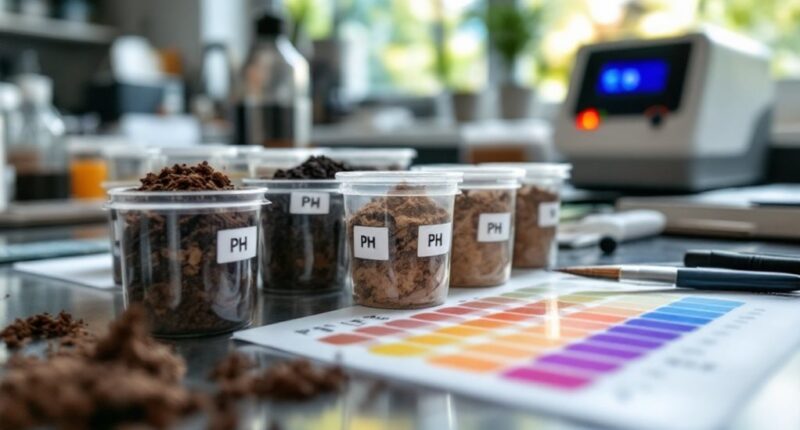Soil testing is agriculture’s equivalent of a medical checkup, revealing vital soil chemistry that impacts plant growth and environmental health. Like a scientific detective, it analyzes pH levels, nutrient content, and potential contaminants through methods ranging from simple color tests to sophisticated spectroscopy. Farmers use this data to optimize fertilization, avoid nutrient runoff, and select appropriate crops, while environmental scientists track contamination and remediation efforts. This invisible foundation determines whether your garden thrives or merely survives.

While many gardeners and farmers might dismiss soil testing as a technical luxury, understanding what lies beneath our feet serves as the foundation for successful agricultural endeavors and environmental management. It’s not unlike getting a physical exam for your land – except soil doesn’t complain about turning its head and coughing. Proper testing reveals the hidden chemistry that determines whether your plants will throw a growth party or stage a wilting protest.
Collecting soil samples isn’t just jabbing a shovel wherever convenience dictates. Methods like composite sampling (the “potluck approach” where multiple samples get mixed) or grid sampling (think of it as soil’s version of tic-tac-toe) provide different insights depending on your needs. Zone sampling targets specific field characteristics – because treating all soil the same is like assuming all teenagers have identical music taste. Proper sampling requires collecting soil at specific depths depending on what you’re growing, with trees needing deeper samples than lawns.
Smart soil sampling demands strategy—random digging yields random results, while methodical approaches unlock the earth’s true story.
Before analysis, samples undergo a makeover routine that would impress any beauty influencer: drying, grinding, sieving, and careful labeling. This isn’t just scientific fussiness – it’s guaranteeing that your tablespoon of soil accurately represents acres of land. Without proper preparation, your results would be about as reliable as weather predictions from a magic 8-ball.
The analytical arsenal includes tests ranging from simple pH measurements (soil’s mood ring) to sophisticated instrumental techniques like atomic absorption spectroscopy – fundamentally giving soil a high-tech interrogation about its metal content. Colorimetric methods turn chemical reactions into a chromatic show where color intensity reveals nutrient concentrations. Comprehensive analysis typically examines major nutrient levels like nitrogen, phosphorus, and potassium, which are essential for plant growth and development.
Interpreting results requires context – a pH of 6.2 means nothing without knowing whether you’re growing blueberries (which love acidity) or alfalfa (which doesn’t). This is where comparison to established guidelines becomes essential. Quality control measures ascertain your results aren’t just scientific fiction, employing reference materials and duplicate analyses.
Beyond agriculture, soil testing serves environmental sentinels, tracking contamination, monitoring remediation progress, and evaluating overall soil health. It’s the unsung hero of environmental science – revealing stories written in the earth itself.
Frequently Asked Questions
How Do Seasonal Variations Affect Soil Test Results?
Seasonal variations substantially impact soil test results. pH and phosphorus typically measure higher in spring than fall, while potassium shows variable seasonal patterns. Temperature affects microbial activity and nutrient cycling, with activity appreciably reduced below 10°C.
Moisture conditions influence sampling accuracy – dry soil increases sampling errors and can alter pH readings by 0.1-0.4 units. For consistent year-to-year comparisons, experts recommend sampling during the same season annually to minimize these fluctuations.
Can Home Soil Testing Kits Replace Professional Laboratory Analysis?
Home soil testing kits cannot fully replace professional laboratory analysis. While convenient and affordable, these DIY options typically offer limited accuracy, especially for nutrient testing. They provide basic readings of major nutrients and pH but miss micronutrients and contaminants entirely.
Professional labs deliver precise measurements, thorough analysis, and expert recommendations tailored to specific crops and soil types. Home kits serve better as supplementary tools for quick checks between professional tests or for educational purposes in home gardens.
How Often Should Agricultural Soil Be Tested?
Agricultural soil testing frequency depends on several factors. Most field cropping systems benefit from testing every 3-4 years, while high-value crops like vegetables require annual testing. Hay systems and double-cropping should be tested every 2 years.
Sandy soils with low cation exchange capacity need more frequent testing (1-2 years). The timing matters too—fall is ideal, allowing farmers to plan spring applications while maintaining consistent testing periods for accurate trend analysis.
What Contaminants Aren’t Detected by Standard Soil Tests?
Standard soil tests often miss several important contaminants that can lurk beneath the surface. Pesticides, herbicides, petroleum hydrocarbons, VOCs, PCBs, and emerging concerns like PFAS typically fly under the radar.
These tests also won’t detect microplastics, pharmaceutical residues, pathogens, nanoparticles, or certain industrial chemicals. Like a basic medical checkup that misses underlying conditions, standard soil analyses provide limited insight without specialized testing targeted to the site’s specific history and characteristics.
How Do Soil Amendments Impact Test Timing?
Soil amendments markedly influence when testing should occur. For accurate results, experts recommend waiting 1-2 months after application, allowing amendments to properly interact with soil.
Different amendments require various waiting periods: lime needs 3-6 months to fully react, compost releases nutrients over 4-6 months, while chemical fertilizers act within weeks. Testing too soon after amendment application can produce skewed results that don’t reflect true soil conditions, potentially leading to improper future treatment decisions.









